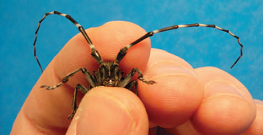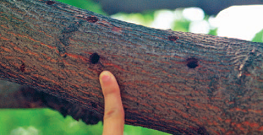Invasion of the Asian Longhorned Beetle
Increasing international trade may be good for globalization but it’s been devastating some plant and insect species throughout the U.S.
 As trade increases, so does the volume of cargo containers entering the States from the far reaches of the globe. The problem is these containers often carry pint-sized stowaways, hiding in wood packing materials, that are capable of devastating entire plant species across a region or even destroying an ecosystem in a very short time.
As trade increases, so does the volume of cargo containers entering the States from the far reaches of the globe. The problem is these containers often carry pint-sized stowaways, hiding in wood packing materials, that are capable of devastating entire plant species across a region or even destroying an ecosystem in a very short time.
Our native plants have no natural defenses against these non-native invasive species and there is rarely a natural predator present to keep the natural balance in check. Thus, invasive insects — like invasive plants — can spread quickly, and devastate other species. One extreme example of this is the Asian longhorned beetle (Anoplophora glabripennis).
Native to the Asian continent, the Asian longhorned beetle (ALB) was first detected in the United States in 1996 in the Greenpoint section of Brooklyn. A couple of years later, in 1998 it was discovered in Long Island and Chicago. At present, ALB is well established in parts of New York and Massachusetts and threatens New Jersey, Pennsylvania, Ohio, Delaware, Rhode Island, Connecticut, New Hampshire and Vermont.
ALB has the potential to be one of the most devastating pests of all time threatening urban, suburban, recreational and forest trees valued in the hundreds of billions of dollars. To date, tens of thousands of trees have had to be removed and destroyed to stop the spread of ALB, costing an estimated $200 million. It also threatens such industries as maple syrup production, lumber, nurseries and tourism. Some suggest that it could prove Dutch elm disease and chestnut blight to be minor in comparison — declaring the ALB issue to be “on the same magnitude as a natural disaster.”
 Control is Difficult BUT Not Impossible
Control is Difficult BUT Not Impossible
The U.S. Department of Agriculture’s Animal and Plant Health Inspection Service (APHIS) has been on the case for some time and continues to research and test possible solutions. Since the beetle lives most of its life cycle inside the tree, conventional insecticides are of no value. Currently, the only effective measure to curtail the spread is to remove and destroy the infested tree (either by chipping or burning it).
Chicago’s Success
Even though the beetle continues to spread in the Northeast, in 2008 it was declared eradicated in Chicago.
Chicago’s efforts have proved to be an interesting and effective model for the rest of the nation to follow. The city of Chicago, state of Illinois and APHIS officials quickly coordinated with an entomologist and immediately began surveying trees in the affected area. The Mayor took an active role holding a press conference that was carried internationally stirring public interest. Government officials and residents joined forces to battle the beetle. All parties worked together to develop a strategic plan that would officially eradicate the pest. The plan included quarantining infested areas, removing and destroying infested trees, treating healthy trees with Imidacloprid (a pest control solution) and continuing to survey previously affected areas for four years following the treatments to ensure that the beetle was indeed gone. After the four years, the area would be declared eradicated. Finally, they reforested the community using species not susceptible to ALB.¹
 Chicago’s success at eradicating the Asian longhorned beetle can be attributed to early detection and a collaborative effort on the part of local, state and federal government agencies, the research community, and residents all implementing a strategic plan.
Chicago’s success at eradicating the Asian longhorned beetle can be attributed to early detection and a collaborative effort on the part of local, state and federal government agencies, the research community, and residents all implementing a strategic plan.
There needs to be a concerted effort to help stop the spread of Asian longhorned beetle. Without community involvement, it is unlikely that the beetle will be contained, let alone eradicated, any time soon. If you suspect that you have a tree infested with ALB, do not remove the tree yourself. A certified arborist or your local forestry officials can take the necessary steps to remove and dispose of the infestation.
¹ Judy Antipin and Thomas Dilley, Chicago vs. Asian Longhorn Beetle: A Portrait of Success, http://www.na.fs.fed.us/spfo/pubs/misc/albsuccess/alb_success.pdf
Photo credits: www.bugwood.org – from top to bottom: Michael Bohne; Dennis Haugen, USDA Forest Service; Kenneth R. Law, USDA Aphis PPQ; E. Richard Hoebeke, Cornell University





